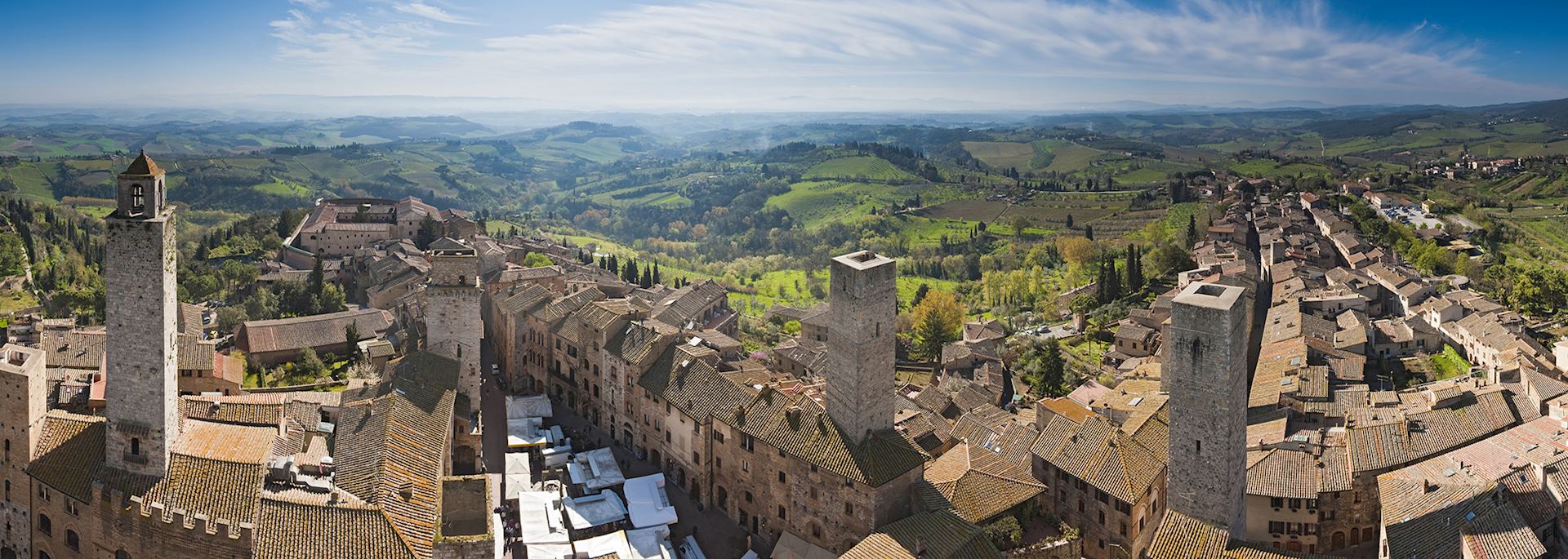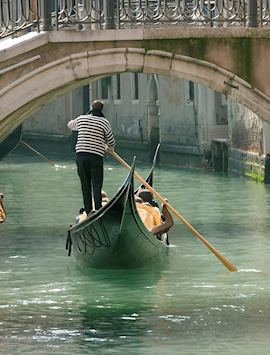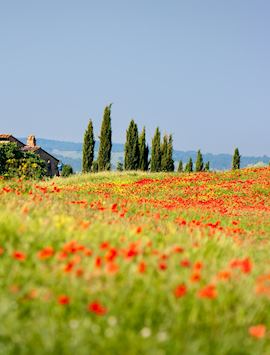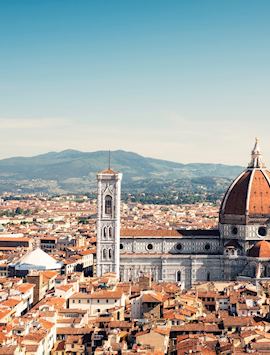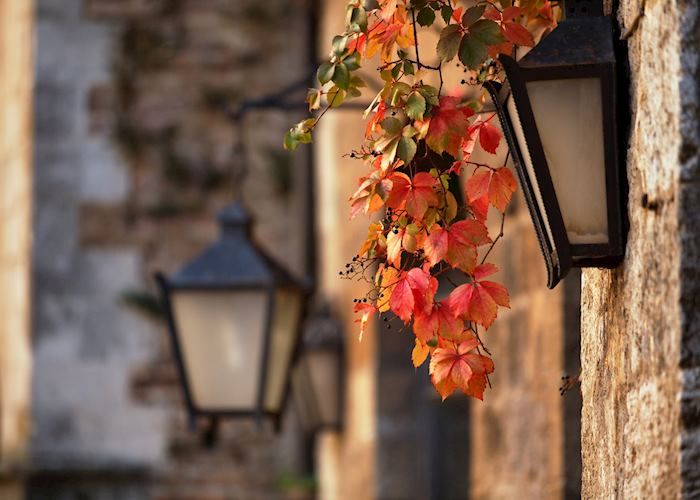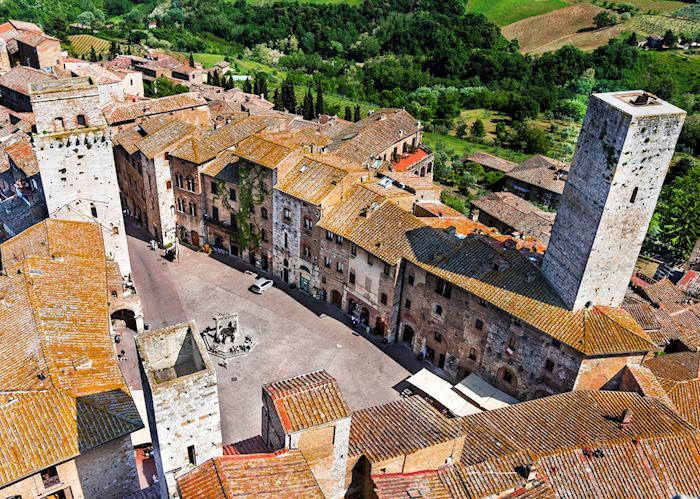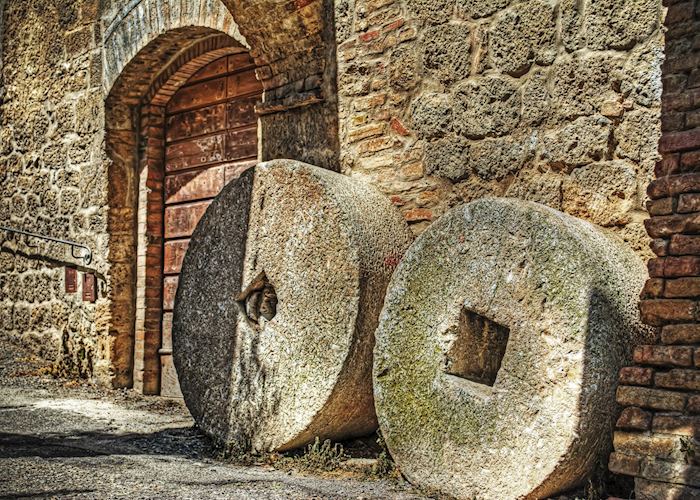Jump to:
The walled medieval village of San Gimignano, halfway between Florence and Siena, is perched on the top of a hill in typical Tuscan style. It's beautifully preserved medieval streets are dominated by a forest of 12th and 13th-century towers built by the village’s noble inhabitants as competing symbols of their wealth. At its peak, there were 72 towers, though just 14 remain today. San Gimignano's picturesque rural setting and atmospheric medieval architecture make it a popular day trip from Florence, and you’ll find plenty of good trattorias along with shops selling locally-produced saffron and the fruity white Vernaccia di San Gimignano wine.
Italy specialist KimberlyA hilltop idyll, San Gimignano is small enough to be explored during a leisurely afternoon and yet full of interesting nooks and crannies, with several towers you can climb for views over the Tuscan countryside.
Things to see and do in San Gimignano
Duomo
San Gimignano's Romanesque collegiate church was consecrated by the pope in 1148 and is most famous for its magnificent frescoes. Set on the Via Francigena, the pilgrimage route to Rome, the church grew along with the town's fortunes and by the 14th century was able to commission leading artists to complete its cycle of vivid frescoes. These remarkable artworks are generally very well preserved and depict scenes from the Old and New Testaments as well as stories about local Saint Fina, who is celebrated in a beautiful side chapel decorated in an elaborate Renaissance style.
Piazza della Cisterna
Named after the 13th-century well at its heart, triangular Piazza della Cisterna is one of the town's two main squares. It's surrounded by a rich collection of medieval houses and towers, once owned by the town's most affluent citizens. An ancient city gate, Arco dei Becci, sits in its southwest corner flanked by further towers. The square would have been originally used for markets and public events, but today it's a wonderful place to linger over coffee in one of the cafés before exploring the narrow side streets that branch off into the town.
Palazzo Comunale & Torre Grossa
The 13th-century Palazzo Comunale, or municipal palace, has been the heart of civic society in San Gimignano for centuries and today still houses the town council offices. In times past, dignitaries would have addressed the crowd in the square below from the first floor gallery. Today, the interiors remain much as they would have been in medieval times with intricate frescoes of castles and rural scenes, as well as religious works and, in the Camera del Podestà, unusual matrimonial scenes. The palazzo is adorned with the village's highest tower, the 54 m (177 ft) Torre Grossa, which you can climb for spectacular views of the surrounding landscape.
who's been there
-
617-223-4521617-223-4395
- Make an inquiry
Suggested itineraries featuring San Gimignano
Our itineraries will give you suggestions for what is possible when you travel in San Gimignano, and they showcase routes we know work particularly well. Treat them as inspiration, because your trip will be created uniquely by one of our specialists.
Places near San Gimignano
- Siena 18 miles away
- Florence 24 miles away
- Pisa 37 miles away
- Forte dei Marmi 56 miles away
- Perugia 73 miles away
- Porto Venere 73 miles away
- Bologna 73 miles away
- Orvieto 75 miles away
- Cinque Terre 79 miles away
- Umbria 82 miles away
- Modena 82 miles away
- Assisi 85 miles away
- Ravenna 88 miles away
- Parma 99 miles away
- Portofino and Santa Margherita 109 miles away
- Genoa 124 miles away
- Rome 132 miles away
- Verona 137 miles away
- Sirmione 141 miles away
- Lake Garda 150 miles away
- Venice 151 miles away
- Gardone Riviera 151 miles away
- Milan 166 miles away
- Barbaresco 171 miles away
- Alba 172 miles away
- Barolo 174 miles away
- Costa Smeralda 181 miles away
- Como 189 miles away
- Blevio 190 miles away
- Torno 191 miles away
- Madonna di Campiglio 192 miles away
- Laglio 192 miles away
- Lezzeno 194 miles away
- Bellagio 195 miles away
- Piedmont 197 miles away
- Tremezzo 197 miles away
- Lake Como 199 miles away
- Turin 200 miles away
- Dolomites 208 miles away
- Stresa 208 miles away
- Verbania 210 miles away
- Lake Maggiore 210 miles away
- Alta Badia 220 miles away
- Ischia 241 miles away
- Naples 246 miles away
- Herculaneum 251 miles away
- Sardinia 255 miles away
- Pompeii 259 miles away
- Capri 260 miles away
- Sorrento 261 miles away
- The Amalfi Coast 268 miles away
Photos of San Gimignano
Our expert guides to exploring San Gimignano
Written by our specialists from their own experiences of visiting San Gimignano, these guides will help you make the most of your time there. We share both our practical recommendations and the best ways to appreciate San Gimignano at its best.
-
Food highlights of Italy ![Italian market produce]()
Food highlights of Italy
Food highlights of Italy
Italy specialist Caroline talks about her love of Italian food in this guide, focusing on the more renowned culinary cities and regions. She also talks about her experiences of creating pasta, catching fresh fish for dinner in Sorrento, wine tasting in Tuscany's Chianti region and where to eat like a local.
Read this guide
